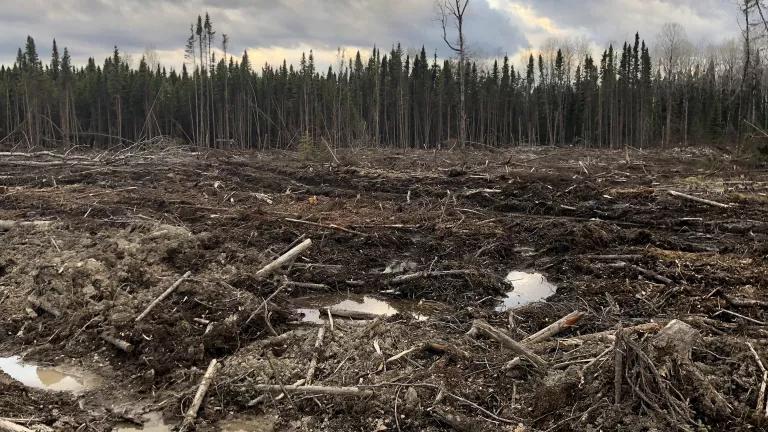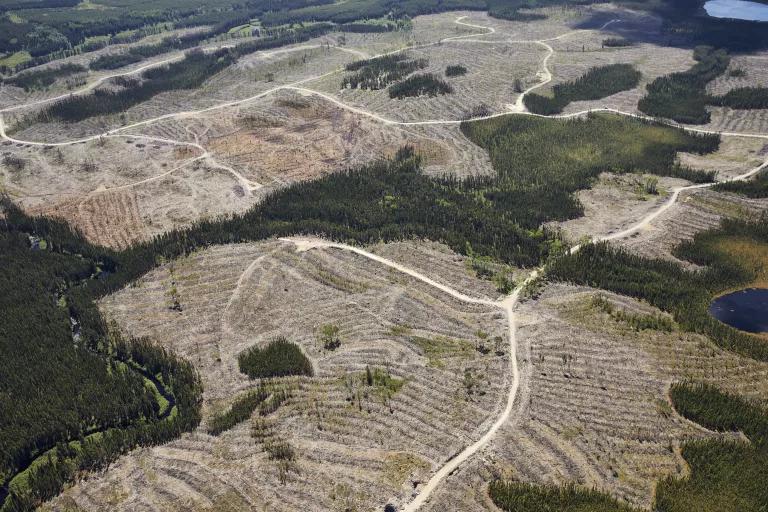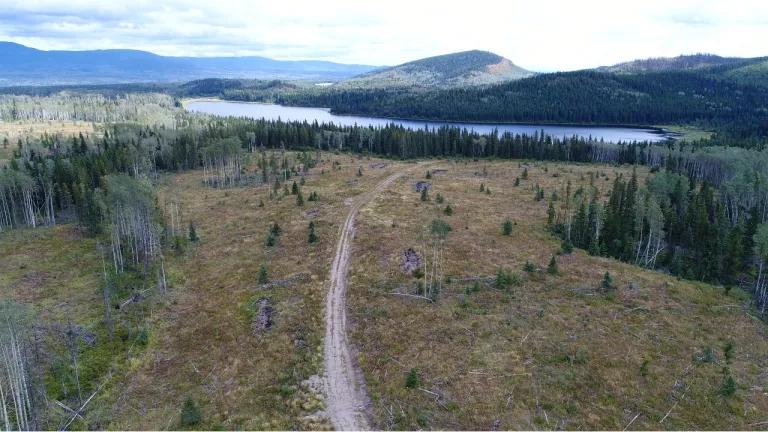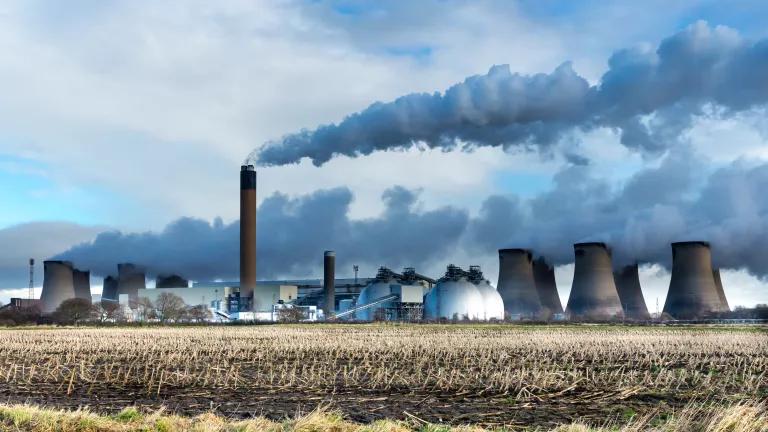The Crumbling Myth of Consequence-Free Intact Forest Loss
For decades, an unchecked myth that forests are a renewable resource has permeated how we view, consume, and regulate forests.

Clearcut logging in Quebec, still considered a healthy forest
For decades, an unchecked myth that forests are a renewable resource has permeated how we view, consume, and regulate forests. In international parlance, the very meaning of the word “deforestation” is tied not to the act of cutting down trees, but how the forest is used afterwards: a stump-filled landscape is still deemed a forest if it’s replanted with saplings or allowed to regrow. Instead, companies can downplay their forest impacts with tenuous promises of nature’s capacity to heal and boasts that for every tree their suppliers cut down, they plant one (or even two!) in its stead, as if forests were a machine of discrete, interchangeable parts. It’s a notion based on a mixture of hubris and denial and fueled by corporate profit margins, that somehow we can raze centuries-old forests without consequence. That we can clearcut a forest and have it not even count as deforestation.
But now, that myth is crumbling, with a groundswell of scientists, policymakers, and marketplace leaders raising an urgent alarm about the climate and biodiversity calamities that await if we don’t recognize the irreplaceability of the remaining intact forests we have left.
Intact forests—also called primary forests—are forests that have never been industrially disturbed and have irreplaceable value for the global climate and biodiversity. They store vast amounts of carbon in their vegetation and soils and are home to treasured species found nowhere else on earth. But their unique value has largely been erased in international commitments that focus on “deforestation”—the actual conversion of a clearcut forest to some other non-timber purpose like agricultural land—rather than intact forest loss (or forest “degradation”). The assumption is that the forest—or at least merchantable trees—will regrow, so no need to concern ourselves with the barren, bereft scene there now.
It’s a construct driven not just by the audacity of assuming that industry can recreate centuries-old ecosystems, but also by colonialism. It just so happens that this narrow definition of “deforestation” falls along geopolitical lines, with Northern countries much more commonly engaged in what they define as “degradation” rather than deforestation. This means that their logging industries have been able to largely fly under the international radar, avoid the baggage associated with the term “deforestation,” and obscure the reality of the churned-up landscapes they’re leaving behind. It means that countries can claim world-class forestry practices, even as they raze carbon-rich forests and at-risk species’ habitat.
The scheme has worked for over thirty years. Forest conventions and international attention focused on deforestation in the tropics, giving Northern forest degradation a free pass. Marketplace frameworks like the New York Declaration on Forests, despite its global-sounding title, largely haven’t touched intact forest loss in the North. U.S. policymakers have adopted policies to push Brazilian leaders to end forest loss without looking at the forest loss closer to home. As renowned forest ecologist Bill Moomaw wrote, “There are four international agreements on forests. They all apply to tropical forests. Isn't it interesting that Europeans and Americans don't think that their forests should play a role?"

Clarcut logging in Ontario
In the meantime, the intact forests of Canada, Sweden, Russia, and other Northern countries quietly disappeared. In recent years, the first- and third-highest intact forest landscape loss in the world has happened in Russia and Canada, respectively, while, in the last 60 years, Sweden has lost over 70% of its lichen-rich forests to the logging industry. The greatest tree loss per capita is happening in Sweden, Norway, Canada, and Russia, which all are boreal countries.
However, that free pass for Northern countries is ending.
As the world continues to barrel toward climate catastrophe and mass species collapse, scientists are increasingly calling attention to the fact that we have to look beyond narrow definitions of deforestation to address what’s happening in more broadly our intact forests.
In a groundbreaking new report that highlights the need to tackle climate change and biodiversity loss with unified, comprehensive solutions, leading scientists call for transformative economic change that includes a wholesale reevaluation of how we use and value our forests. The report stresses that “avoiding and reversing the loss and degradation of carbon- and species-rich ecosystems on land and in the ocean is of highest importance for combined biodiversity protection and climate change mitigation actions with large adaptation co-benefits.”
This report came on the heels of a joint statement from countries as part of the Forest, Agriculture and Commodity Trade (FACT) Dialogue that looks beyond deforestation frameworks and acknowledges the role that forest degradation plays in driving global climate change. Even officials in Canada, which has a logging industry that continues to insist on the inherent sustainability of replanting clearcut primary forests, have called on the international community to address the loss of intact forests.
The shift is also happening in the marketplace. Last October, 67% of Procter & Gamble’s shareholders voted in favor of a resolution requiring the company to report on steps it is taking to address both tropical and boreal deforestation and primary forest degradation. Leading investors such as BlackRock, State Street, and Vanguard supported the resolution, demonstrating a new recognition of the risk companies face when their supply chains are associated with the degradation of intact forests.
In California, the State Assembly recently passed a bill that would implement new procurement requirements around tropical and boreal deforestation and primary forest degradation, along with guaranteeing fundamental Indigenous rights. The bill, supported by investors with assets valued at over $1.5 trillion, signals the state’s recognition that climate leadership is no longer possible without addressing impacts on forest degradation.
The urgency of ending intact forest degradation doesn’t mean a halt to all logging. It means that, with only 20% of the world’s intact forests remaining, we can’t afford to erode the irreplaceable we have left to make toilet paper and 2x4’s.
As California and others are illustrating, climate and biodiversity leadership is increasingly hinging upon recognizing that razing centuries-old forests is fundamentally incompatible with creating a livable future. No matter the industry spin or international frameworks, the disappearance of our remaining intact forests will have an irrecoverable toll—which no amount of tree planting will rectify. Intact forests, in all their rich, intricate, interwoven complexity are, by definition, irreplaceable.


